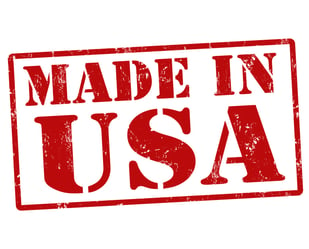 Years ago, the label “made in America” was a source of pride, not just for manufacturers, but for customers as well. For many, that label meant a quality product assembled to the highest standards, something worth every penny of the cost.
Years ago, the label “made in America” was a source of pride, not just for manufacturers, but for customers as well. For many, that label meant a quality product assembled to the highest standards, something worth every penny of the cost.
Somewhere along the line, the “made in America” label began to become less common. Instead of making goods in American factories using American labor, it became more expedient and cost-effective to offshore that labor to other countries where the labor was cheap.
As work was offshored to foreign countries, manufacturing jobs in the United States began to dry up.
However, “made in America” isn’t dead yet. In fact, after years of a trend where businesses were moving their production overseas, we are now seeing a trend where businesses are moving their production back to the USA, reshoring jobs and growing the manufacturing industry’s GDP.
Reshoring of Manufacturing Jobs is Growing
According to a Reshoring Initiative study featured on marketwatch.com, “Sixty thousand manufacturing Jobs were added in the U.S. in 2014… In contrast, as many as 50,000 jobs were ‘offshored’ last year.” This represents a net increase of roughly 10,000 new jobs being added to the U.S. manufacturing job market last year.
As stated in the Market Watch article, this represents “the first net gain in at least 20 years.”
To put this in perspective, there are people now entering the job market who were born and became young adults in the time it took to finally see a net gain in the number of manufacturing jobs in the U.S.
This resurgence in manufacturing sector job growth is a strong indication that the manufacturing sector is seeing a revivification. As demand for manufactured goods increases, employers are adding more workers to keep up with the expected demand.
Why are these companies moving their operations back into America instead of investing more in overseas manufacturing?
Reasons Why Manufacturing Companies are Reshoring
 One of the key factors helping to convince many manufacturers to move jobs back to American factories rather than overseas ones is the issue of labor costs.
One of the key factors helping to convince many manufacturers to move jobs back to American factories rather than overseas ones is the issue of labor costs.
In decades past, the cost of labor in countries such as China and India was much cheaper than labor costs in America. Foreign countries often didn’t have as many regulations as the U.S., and the labor itself was much less costly per hour.
However, in recent years, the cost of labor in foreign countries has increased. Not only are more regulations being added to business operations overseas, the cost of labor is creasing in many of these areas as well. This minimizes the cost advantage of using foreign labor, causing many employers to reconsider where they establish their production operations.
Another contributing factor is the placement of production centers relative to consumers. In several production industries, customers want what they want, when they want it. Delays in getting products to the market where consumers can buy them may mean the difference between a wildly successful product launch and having a stockpile of unsellable merchandise made for a now-gone fad.
Additionally, by placing production in the domestic U.S., companies are able to avoid some of the shipping costs and import taxes/duties that they would otherwise have to face when shipping from an overseas location.
On top of avoiding import costs and the shrinking labor cost gap between the U.S. and foreign countries, American workers tend to be more productive per hour than their overseas counterparts. The heavier adoption of manufacturing automation by American workers and companies plays no small part in this productivity advantage. Because of this, the cost-to-benefit ratio is definitely weighted in the favor of U.S. manufacturing workers.
Whatever the reason, the growth of U.S. manufacturing jobs as work reshoring takes effect is good news for the American economy as it boosts the national GDP, adds to the taxpayer base, and puts more spending money in the hands of the middle class.
We here at Marlin Steel are looking forward to more positive news for the manufacturing industry and the American economy in the coming months.



.gif)


